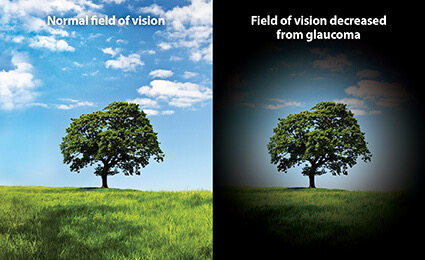Glaucoma is not a single disease, but more of a collection of disorders that cause damage to the optic nerve. This damage causes vision loss and blindness. This damage can be caused quickly or slowly over time. Usually, we think of elevated ocular pressure with glaucoma, but there are instances when ocular pressure is normal and a patient can still have glaucoma.
Glaucoma is primarily broken into two main categories, open and closed angle glaucoma. Open angle comprises most of the glaucoma in the world, is usually slowly progressive and asymptomatic, only causing slow peripheral vision loss over time. Closed angle glaucoma is more acute with a sudden onset, and sudden blurry vision with pain and redness and a very elevated eye pressure. This is treated as an emergency and often needs a surgical procedure to get the eye pressure controlled.

Glaucoma is not a curable disease. However, it is manageable with proper treatment. Typically management will focus on ocular pressure control. This can be accomplished by several different methods. Medication in the form of eye drops is the first option. These drops are usually taken anywhere from once to three times a day. Pills can be used, but usually are not as effective. Multiple drops are available and often combinations of drops are needed to adequately control eye pressure and glaucoma. Laser can be used to help control glaucoma and can usually be done in an office setting. This type of laser is noninvasive and basically gives a similar result to using a single medication. Thus, if the laser is effective it may keep a patient from having to start or add a daily medical drop.
Other methods of treatment are surgical in nature and I will discuss those at another time.

The goal of treatment, whether medical or surgical, is to lower the eye pressure to a level so that no damage to the optic nerve occurs. We calculate and measure the damage from glaucoma in a variety of ways. Determining the function of the optic nerve is done as one of these methods. Most commonly the function of the nerve is measured with a Visual Field test where a patient’s peripheral vision is mapped out and then compared overtime looking for changes. These tests take about 30 minutes and are done in an office setting. More recently we are able to examine the nerve anatomy with a scan of the retina and nerve, also done in the office. I would say this is similar to getting a “CAT scan” of the back part of the eye. This is called an OCT of the optic nerve and retina. These scans allow us to evaluate the anatomy of the nerve looking for changes over time that would predict a loss in vision and the overall function of the optic nerve.
Well, that is a lot about Glaucoma. The takeaway message is that Glaucoma, while serious, can be effectively managed and treated but time is important as the disease typically worsens over time and with age.

Click here to learn more about Dr. Kevin Toller!

